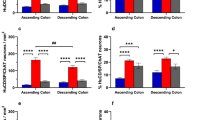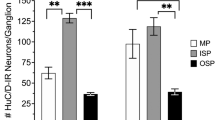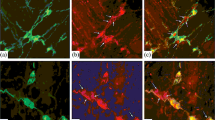Abstract
The submucous layers of human small and large intestines contain at least two separate neuron populations. Besides morphological features, they differ in their immunoreactivities for calretinin (CALR) and somatostatin (SOM), respectively. In this study, submucosal wholemounts of 23 patients or body donors (including all segments of small intestine and colon) were immunohistochemically quadruple stained for CALR and SOM as well as for substance P (SP) and choline acetyltransferase (ChAT). We found that all SOM-positive neurons co-stained for ChAT and the majority for SP [between 50 % in the small intestinal external submucosal plexus (ESP) and 75 % in the colonic ESP]. In contrast, a majority of CALR-neurons contained ChAT (between 77 % in the small intestinal ESP and 92 % in the large intestinal ESP) whereas less than 4 % of CALR-neurons were co-immunoreactive for SP. Another set of wholemounts was co-stained for peripherin, a marker enabling morphological analysis. Where identifiable, both SOM alone- and SOM/SP-neurons displayed a uniaxonal (supposed pseudouniaxonal) morphology. We suggest that the chemical code of SOM-immunoreactive, human submucosal neurons may be “ChAT+/SOM+/SP±”. In additional sections double stained for SOM and SP, we regularly found double-labelled nerve fibres only in the mucosa. In contrast, around submucosal arteries mostly SOM alone- fibres were found and the muscularis propria contained numerous SP-alone fibres. We conclude that the main target of submucosal SOM(/SP)-neurons may be the mucosa. Due to their morpho-chemical similarity to human myenteric type II neurons, we further suggest that one function of human submucosal SOM-neurons may be a primary afferent one.







Similar content being viewed by others
References
Accili EA, Dhatt N, Buchan AM (1995) Neural somatostatin, vasoactive intestinal polypeptide and substance P in canine and human jejunum. Neurosci Lett 185:37–40
Beck M, Schlabrakowski A, Schrödl F, Neuhuber W, Brehmer A (2009) ChAT and NOS in human myenteric neurons: co-existence and co-absence. Cell Tissue Res 338:37–51
Brehmer A, Blaser B, Seitz G, Schrödl F, Neuhuber W (2004a) Pattern of lipofuscin pigmentation in nitrergic and non-nitrergic, neurofilament immunoreactive myenteric neuron types of human small intestine. Histochem Cell Biol 121:13–20
Brehmer A, Croner R, Dimmler A, Papadopoulos T, Schrödl F, Neuhuber W (2004b) Immunohistochemical characterization of putative primary afferent (sensory) myenteric neurons in human small intestine. Auton Neurosci 112:49–59
Brehmer A, Lindig TM, Schrödl F, Neuhuber W, Ditterich D, Rexer M, Rupprecht H (2005) Morphology of enkephalin-immunoreactive myenteric neurons in the human gut. Histochem Cell Biol 123:131–138
Brehmer A, Rupprecht H, Neuhuber W (2010) Two submucosal nerve plexus in human intestines. Histochem Cell Biol 133:149–161
Brookes SJ (2001) Classes of enteric nerve cells in the guinea-pig small intestine. Anat Rec 262:58–70
Christofi FL, Zhang H, Yu JG, Guzman J, Xue J, Kim M, Wang YZ, Cooke HJ (2001) Differential gene expression of adenosine A1, A2a, A2b, and A3 receptors in the human enteric nervous system. J Comp Neurol 439:46–64
Costa M, Brookes SJ, Steele PA, Gibbins I, Burcher E, Kandiah CJ (1996) Neurochemical classification of myenteric neurons in the guinea-pig ileum. Neuroscience 75:949–967
De Fontgalland D, Wattchow DA, Costa M, Brookes SJ (2008) Immunohistochemical characterization of the innervation of human colonic mesenteric and submucosal blood vessels. Neurogastroenterol Motil 20:1212–1226
Engel MA, Becker C, Reeh PW, Neurath MF (2011) Role of sensory neurons in colitis: increasing evidence for a neuroimmune link in the gut. Inflamm Bowel Dis 17:1030–1033
Furness JB (2006) The enteric nervous system. Blackwell, Oxford
Furness JB, Costa M (1987) The enteric nervous system. Churchill Livingstone, Edinburgh
Gross KJ, Pothoulakis C (2007) Role of neuropeptides in inflammatory bowel disease. Inflamm Bowel Dis 13:918–932
Harmar AJ (2004) Clinical endocrinology and metabolism. Receptors for gut peptides. Best Pract Res Clin Endocrinol Metab 18:463–475
Hens J, Vanderwinden JM, De Laet MH, Scheuermann DW, Timmermans JP (2001) Morphological and neurochemical identification of enteric neurones with mucosal projections in the human small intestine. J Neurochem 76:464–471
Hökfelt T, Pernow B, Wahren J (2001) Substance P: a pioneer amongst neuropeptides. J Intern Med 249:27–40
Holzer P, Holzer-Petsche U (1997a) Tachykinins in the gut. Part I. Expression, release and motor function. Pharmacol Ther 73:173–217
Holzer P, Holzer-Petsche U (1997b) Tachykinins in the gut. Part II. Roles in neural excitation, secretion and inflammation. Pharmacol Ther 73:219–263
Jabari S, da Silveira AB, de Oliveira EC, Neto SG, Quint K, Neuhuber W, Brehmer A (2012) Selective survival of calretinin- and vasoactive-intestinal-peptide-containing nerve elements in human chagasic submucosa and mucosa. Cell Tissue Res 349:473–481
Kramer K, da Silveira AB, Jabari S, Kressel M, Raab M, Brehmer A (2011) Quantitative evaluation of neurons in the mucosal plexus of adult human intestines. Histochem Cell Biol 136:1–9
Kustermann A, Neuhuber W, Brehmer A (2011) Calretinin and somatostatin immunoreactivities label different human submucosal neuron populations. Anat Rec (Hoboken) 294:858–869
Quartu M, Polak JM, Del Fiacco M (1993) Neuropeptides in the human celiac/superior mesenteric ganglionic complex: an immunohistochemical study. J Chem Neuroanat 6:79–99
Schnell SA, Staines WA, Wessendorf MW (1999) Reduction of lipofuscin-like autofluorescence in fluorescently labeled tissue. J Histochem Cytochem 47:719–730
Weidmann S, Schrödl F, Neuhuber W, Brehmer A (2007) Quantitative estimation of putative primary afferent neurons in the myenteric plexus of human small intestine. Histochem Cell Biol 128:399–407
Acknowledgments
The excellent technical assistance of Karin Löschner, Stefanie Link, Anita Hecht, Andrea Hilpert and Hedwig Symowski is gratefully acknowledged.
Author information
Authors and Affiliations
Corresponding author
Rights and permissions
About this article
Cite this article
Beyer, J., Jabari, S., Rau, T.T. et al. Substance P- and choline acetyltransferase immunoreactivities in somatostatin-containing, human submucosal neurons. Histochem Cell Biol 140, 157–167 (2013). https://doi.org/10.1007/s00418-013-1078-9
Accepted:
Published:
Issue Date:
DOI: https://doi.org/10.1007/s00418-013-1078-9




